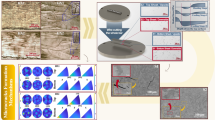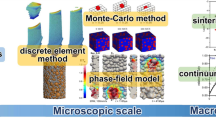Abstract
The objective of this this study is to investigate the distribution of crack initiation sites in the unsteady solidification conditions of pulsed laser welding for an AA2024 aluminum alloy, using both analytical and experimental methods. The employed analytical model considers the competition between volume change rate and liquid flow rate during the final stages of solidification. The former has a direct relationship with solidification rate (r), the latter has an inverse relationship with the length of the crack-vulnerable zone (l), and the risk of cracking decreases with lower values of r × l. According to this model, the distribution of crack initiation sites is more strongly influenced by the solidification rate profile, specifically the solidification rate at the fusion line (rFL) and at the weld center (rWC). The crack initiation site will move toward the weld center as (rWC-rFL)/rFL increases. The model states that in square-wave pulse welded samples, a decrease in rFL caused by preheating causes crack initiation sites to move from the FL toward the WC and crack severity to decrease. Moreover, it was shown that ramp down pulse shaping was more effective at reducing cracks, as both r and l can be controlled and, in turn, r × l can be reduced enough to prevent crack initiation. The model’s reliability was assessed using experimental pulsed laser welding tests that considered the influence of base metal preheating and temporal ramp down pulse shaping.














Similar content being viewed by others
Availability of data and materials
Not applicable.
Code availability
Not applicable.
Change history
03 May 2023
A Correction to this paper has been published: https://doi.org/10.1007/s00170-023-11504-z
References
Coniglio N, Cross CE (2020) Effect of weld travel speed on solidification cracking behavior. Part 1: weld metal characteristics. Int J Adv Manuf Technol 107(11):5011–23
Coniglio N, Cross CE (2020) Effect of weld travel speed on solidification cracking behavior. Part 3: modeling. Int J Adv Manuf Technol 107(11):5039–51
Ghaini FM, Sheikhi M, Torkamany MJ, Sabbaghzadeh J (2009) The relation between liquation and solidification cracks in pulsed laser welding of 2024 aluminum alloy. Mater Sci Eng A 519(1–2):167–171
Michaud EJ, Kerr HW, Weckman DC (1995) Recent trends in welding science and technology, ASM International Congress, Gatlinburg, Tennessee, 153
Sheikhi M, Malek Ghaini F, Torkamany MJ, Sabbaghzadeh J (2009) Characterisation of solidification cracking in pulsed Nd: YAG laser welding of 2024 aluminium alloy. Sci Technol Weld Join 14(2):161–165
Eskin DG, Katgerman L (2004) Mechanical properties in the semi-solid state and hot tearing of aluminum alloys. Prog Mater Sci 49(5):629–711
Suyitno WH, Kool L (2005) Katgerman. Met Mater Trans A 36A:1537–1546
Coniglio N, Cross CE (2020) Effect of weld travel speed on solidification cracking behavior Part 2: testing conditions and metrics. Int J Adv Manuf Technol 107(11):5025–38
MalekshahiBeiranvand Z, MalekGhaini F, Sheikhi M, Abdollah-Zadeh A (2013) Effect of severe plastic deformation on hot cracking of wrought aluminium alloy in pulsed laser welding. Sci Technol Weld Join 18(6):473–477
Cross CE (2005) on the origin of weld solidification cracking. In: Boellinghaus T, Herold H (eds) Hot Cracking Phenomena in Welds. Springer
Sistaninia M, Phillionb AB, Drezeta J-M, Rappaz M (2012) Acta Mater 60:3902–3911
Kou S (2015) A criterion for cracking during solidification. Acta Mater 15(88):366–374
Easton MA, Gibson MA, Zhu S, Abbott TB (2014) An a priori hot-tearing indicator applied to die-cast magnesium-rare earth alloys. Metall and Mater Trans A 45(8):3586–3595
Rappaz M, Drezet J-M, Gremaud M (1999) Met Mat Trans A 30A:449–455
Braccini M, Martin CL, Suéry M, Bréchet Y (2000) Matér Techn 88:19–24
Suyitno WH, Katgerman L (2003) Evaluation of mechanical and non-mechanical hot tearing criteria for DC casting of an aluminum alloy. Light Met 2003:753–758
Sheikhi M, Ghaini FM, Assadi H (2015) Prediction of solidification cracking in pulsed laser welding of 2024 aluminum alloy. Acta Mater 82:491–502
M’hamdi M, Mo A, Martin CL (2002) Two-phase modeling directed toward hot tearing formation in aluminum direct chill casting. Metall Mater Trans A 33(7):2081–93
MJ-Aziz (1988) Mater Sci Eng 98:369–372
Coniglio N, Cross CE (2009) Mechanisms for solidification crack initiation and growth in aluminum welding. Metall Mater Trans A 40(11):2718–2728
Fabregue D, Deschamps A, Suery M, Poole WJ (2006) Rheological behavior of Al-Mg-Si-Cu alloys in the mushy state obtained by partial remelting and partial solidification at high cooling rate. Metall Mater Trans A 37(5):1459–1467
Katayama S, Mizutani M, Matsunawa A (1997) Modelling of melting and solidification behaviour during laser spot welding. Sci Technol Weld Join 2(1):1–9
Trivedi R, Magnin P, Kurz W (1987) Theory of eutectic growth under rapid solidification conditions. Acta Metall 35(4):971–980
Zimmermann M, Carrad M, Kurz W (1989) Acta Mater 37:3305–3313
Jia Z, Zhang P, Yu Z, Shi H, Liu H, Wu D, Ye X, Wang F, Tian Y (2021) Effect of pulse shaping on solidification process and crack in 5083 aluminum alloy by pulsed laser welding. Opt Laser Technol 134:106608
von Witzendorff P, Kaierle S, Suttmann O, Overmeyer L (2015) Using pulse shaping to control temporal strain development and solidification cracking in pulsed laser welding of 6082 aluminum alloys. J Mater Process Technol 225:162–169
Von Witzendorff P, Kaierle S, Suttmann O, Overmeyer L (2015) In situ observation of solidification conditions in pulsed laser welding of AL6082 aluminum alloys to evaluate their impact on hot cracking susceptibility. Metall Mater Trans A 46(4):1678–1688
Gill SG, Kurz W (1995) Acta Mater 43:139–151
Sobolev SL (2016) A novel hybrid model combining continuum local nonequilibrium and discrete variables methods for solute trapping during rapid alloy solidification. Acta Mater 116:212–218
MalekshahiBeiranvand Z, MalekGhaini F, NaffakhMoosavy H, Sheikhi M, Torkamany MJ (2019) An analytical model for prediction of solidification cracking susceptibility in aluminum alloys taking into account the effect of solidification rate. Metall Mater Trans A 50(6):2835–2846
Beiranvand ZM, Ghaini FM, Moosavy HN, Sheikhi M, Torkamany MJ (2019) Solidification cracking susceptibility in pulsed laser welding of Al–Mg alloys. Materialia 7:100417
Author information
Authors and Affiliations
Contributions
Mohsen Sheikhi: investigation, writing. Zeinab Malekshahi Beiranvand: investigation. F. Malek Ghaini: advice. Michael J. Benoit: advice.
Corresponding author
Ethics declarations
Ethical approval
The authors respect the Ethical Guidelines of the Journal.
Consent to participate
Not applicable.
Consent to publication
Not applicable.
Competing interests
The authors declare no competing interests.
Additional information
Publisher's note
Springer Nature remains neutral with regard to jurisdictional claims in published maps and institutional affiliations.
The original online version of this article was revised: Equation 6 has been inserted.
Appendices
Appendix A
Gill et al. [28] reported that the solidification rate dependent liquidus slope (mr) in Eq. (12) can be related to solidification rate dependent distribution coefficient (kr) as follows:
And similarly Sobolev [29] reported that \({C}_{L}^{*}\) can also be stated as a function of kr by:
Iv (PC) is Ivantsov function and PC is the Peclet number of the solute diffusion at dendrite/cell tip. Peclet number was related to tip radius (rt), the solute element diffusion coefficient in the liquid (\({D}_{L}\)), and solidification rate (v) as follows:
It was proposed a local non-equilibrium diffusional model (LNDM) developed for the binary alloys rapid solidification conditions [29,30,31]. Based on this model, kr can be calculated as a function of solidification rate (r), the solute element diffusive speed in the liquid (vDb), and diffusive speed of the solute element across the interface (vDi) by following equation.
Reasonably based on this model when solidification rate reach to the speed of diffusive solute element in the liquid (r = vDb) then kr = 1, i.e., solute trapping at the interface occurs completely.
Appendix B
\(\Delta {T}_{E}\) Can be computed using a model called TMK model [23]. TMK model showed that the parameters of \(\Delta {T}_{E}\) at high solidification rates are dependent on r, as follows:
Here, \({m}_{\theta }\) and \({m}_{\alpha }\) are the slopes of liquidus for θ and α phases. \({a}_{\alpha }^{L}\) and \({a}_{\theta }^{L}\) are the capillarity constants. \({C}_{0}\) is the eutectic tie-line length, f is the α phase volume fraction, and \(\lambda\) is the distance between the eutectic layer. P and \(P+\lambda \left({~}^{\partial P}\!\left/ \!{~}_{\partial \lambda }\right.\right)\) are two series that can be related to the distribution coefficient at α/liquid interface (kα), the Peclet number at the eutectic temperature (p), and f as follows:
and
where
p can be stated as a function of the distance between eutectic layers (λ) [24] and the solute element diffusion coefficient in the liquid (DL) by:
Appendix C
The physical properties and constants for Al-Cu alloys that were used in this investigation are given in Table 6.
Rights and permissions
Springer Nature or its licensor (e.g. a society or other partner) holds exclusive rights to this article under a publishing agreement with the author(s) or other rightsholder(s); author self-archiving of the accepted manuscript version of this article is solely governed by the terms of such publishing agreement and applicable law.
About this article
Cite this article
Sheikhi, M., Beiranvand, Z.M., Ghaini, F.M. et al. Analytical and experimental investigation on the distribution of solidification crack initiation sites throughout a laser spot weld. Int J Adv Manuf Technol 126, 4873–4889 (2023). https://doi.org/10.1007/s00170-023-10953-w
Received:
Accepted:
Published:
Issue Date:
DOI: https://doi.org/10.1007/s00170-023-10953-w




